
HTML page template for aerospace companies
Use TemplateAbout template
Give your aerospace companies a boost with our professional landing page templates. Ready to turn visitors into customers?
Recommended templates

Easy to build without coding
With the intuitive drag-and-drop builder, anyone on your team can create high-converting pages without any knowledge of code or design. Make enhancements to your landing page with custom widgets using Javascript, HTML/CSS, or third-party scripts.

Multiple layouts for any industry and goal
Select from 500+ landing page layouts built to boost conversions across industry-specific scenarios. Customize them by adjusting fonts, adding images, and generating on-brand content with the AI assistant. Quickly scale with Instablocks® and Global Blocks that you can save, reuse, and update globally.

Loads fast and looks polished on any device
Every template is responsive, which means they present professionally on any device and load blazingly fast with our Thor Render Engine. You can also power them up with Google AMP technology to deliver an unparalleled mobile experience and drive higher conversions.

Robust analytics & experimentation
Get real-time updates and reporting across all your devices, showing the number of visitors, conversions, cost-per-visitor, and cost-per-lead. Launch AI-powered experiments, run A/B tests, and use heatmaps to analyze user behavior, then optimize your landing page to maximize conversions.







Easy to build without coding
With the intuitive drag-and-drop builder, anyone on your team can create high-converting pages without any knowledge of code or design. Make enhancements to your landing page with custom widgets using Javascript, HTML/CSS, or third-party scripts.
Multiple layouts for any industry and goal
Select from 500+ landing page layouts built to boost conversions across industry-specific scenarios. Customize them by adjusting fonts, adding images, and generating on-brand content with the AI assistant. Quickly scale with Instablocks® and Global Blocks that you can save, reuse, and update globally.
Loads fast and looks polished on any device
Every template is responsive, which means they present professionally on any device and load blazingly fast with our Thor Render Engine.
Robust analytics & experimentation
Get real-time updates and reporting across all your devices, showing the number of visitors, conversions, cost-per-visitor, and cost-per-lead. Launch AI-powered experiments, run A/B tests, and use heatmaps to analyze user behavior, then optimize your landing page to maximize conversions.
All the features you need to build lead-generating landing pages
Explore more featuresLearn how to build top-performing landing pages for any goal
FAQs
Leading the way in building high-performing landing pages





A powerful tool for creating high-converting landing pages on Instapage
Harnessing the power of Instapage for your digital marketing campaigns can dramatically enhance your effectiveness. Through this guide, you will learn the step-by-step process to create impactful landing pages that cater specifically to the needs of your target audience—ranging from business services to tech and education sectors. With Instapage's robust features, even marketers on a budget can reap extraordinary benefits.
Understanding the basics of landing pages
Landing pages are dedicated web pages designed to capture leads and drive conversions. Unlike traditional websites, landing pages are focused on a singular goal, whether capturing email addresses, generating sign-ups, or promoting a product. By aligning your messaging and design elements with your audience’s needs, your conversion rates will increase significantly. Instapage makes this process seamless with its pre-built templates and intuitive design tools.
- Ease of use: Instapage's user-friendly interface allows anyone, regardless of technical skills, to create landing pages without coding.
- Variety of templates: Access to over 100 customizable templates ensures that you can find the perfect fit for any campaign.
- Conversion optimization tools: Built-in features such as A/B testing and heatmaps help you understand your users' behavior and optimize accordingly.
Step 1: Choose the right template
Select a template that aligns with your campaign's goal and audience preferences. With Instapage, this step does not have to be time-consuming or complicated.
- Identify your campaign goal: Whether it’s lead generation, event registration, or product sales, know what you want to achieve before choosing a template.
- Consider your target audience: Different audiences respond to different designs; choose a template that resonates with your demographic.
- Utilize dynamic text replacement: Customize templates to dynamically match keywords and phrases that cater to specific audience segments.
Step 2: Personalizing your landing page
Using Instapage's personalization features can greatly enhance your campaign effectiveness. By delivering targeted content, you can significantly improve user engagement.
- Dynamic content: Instapage lets you serve content based on user data, ensuring relevance and increasing conversion likelihood.
- Ad mapping: Align your advertisements to specific landing pages for a cohesive user experience.
- Audience tracking: Use advanced metrics to see how different segments of your audience interact with your landing pages.
Step 3: Optimize for performance
After launching your page, continuous monitoring and optimization is crucial. Instapage's built-in tools facilitate this process to ensure you are maximizing ROI.
- Conduct A/B testing: Regularly test variations of your pages to find the highest converting version.
- Analyze user behavior: Utilize heatmaps to see where users are engaging and make data-driven adjustments.
- Leverage analytics: Use detailed analytics dashboards to evaluate every aspect of your landing page’s performance.
By following this structured approach to creating landing pages with Instapage, you will not only streamline your marketing efforts but also maximize your investment in digital advertising.
Ready to take your digital marketing to the next level? Start crafting high-converting landing pages today with Instapage to enhance your ROI!
HTML page template for aerospace companies: Crafting an effective online presence
Understanding HTML page templates in the aerospace sector
HTML page templates are foundational structures for creating web pages. They provide a reusable format, allowing companies, including those in the aerospace sector, to maintain consistency in design while simplifying web development. The importance of these templates cannot be understated, especially with the growing need for aerospace companies to establish an effective web presence.
A well-crafted website serves as a digital storefront, where stakeholders, potential clients, and partners gather information about the organization. For aerospace companies, having a professional web presence showcases credibility, technical prowess, and a commitment to innovation.
Definition and importance of HTML page templates.
Unique requirements like regulatory constraints.
The necessity for precision in technical communication.
Key components of an aerospace HTML page template
When designing an HTML page template for aerospace companies, it's crucial to incorporate aesthetic elements that align with the industry. This includes a color palette that reflects technical sophistication, often utilizing shades of blue, grey, and metallic tones. Such choices not only enhance branding but also help convey the essence of aerospace technology. Additionally, high-quality imagery, such as aircraft, space vehicles, or engineering diagrams, should be thoughtfully integrated to captivate visitors.
Functionality is equally important. Aerospace HTML templates should feature responsive designs that deliver a consistent user experience across various devices. Interactive elements, like video backgrounds demonstrating aerospace innovations or infographics illustrating technical specs, can significantly enhance user engagement and information retention.
Color schemes consistent with aerospace branding.
High-quality visuals relevant to aerospace.
Responsive design for usability on all devices.
Core functionalities of HTML templates for aerospace
Advanced features in an HTML template can serve a pivotal role in enhancing user interaction. For instance, implementing **iolazy** for image loading improves the website's speed during navigation, critical for keeping users engaged. iolazy loads images only when they enter the viewport, which prevents excessive data loading, thus facilitating faster page responses.
Another useful feature is the utilization of **document.addEventListener**, which allows tracking user interactions more effectively. This can be particularly beneficial for conducting surveys or gathering feedback through forms, ensuring that aerospace companies can respond directly to their audience's needs.
Lastly, leveraging the **DOMContentLoaded** event optimizes load times by executing scripts after the HTML document is fully loaded. This is essential for aerospace sites, which often contain large datasets and complex layouts that can slow page performance.
Use of iolazy for efficient image loading.
Implementing document.addEventListener for enhanced interactions.
Optimizing performance with DOMContentLoaded.
SEO optimization techniques for aerospace web pages
SEO is crucial for aerospace companies, given the intense competition in this sector. A solid SEO strategy not only improves visibility but also enhances credibility. Companies must focus on targeted keywords that reflect industry standards and expertise, such as 'aviation technologies,' 'space research,' and 'aerospace engineering.' This strategic inclusion of keywords allows search engines to index content effectively.
On-page SEO strategies also come into play. Crafting meta tags that are both descriptive and relevant provides search engines with context about the website. Structuring content clearly ensures that users can navigate technical information effortlessly, which is essential in an industry where detail and accuracy matter.
Incorporating targeted keywords relevant to aerospace.
Developing descriptive meta tags for better indexing.
Creating structured, easy-to-navigate content.
Integrating content management systems with HTML templates
Integrating an effective content management system (CMS) is vital for aerospace companies looking to streamline their web presence. Popular options like WordPress, Joomla, and Drupal offer flexibility and user-friendly interfaces that help manage complex content. Each platform has unique capabilities that cater to the specific needs of technical industries, enhancing the overall user experience.
To ensure seamless integration, companies can export their customized HTML templates into these CMS platforms. Furthermore, customization and scalability options allow firms to adapt their website as their needs evolve, ensuring they remain relevant as technology advances and market demands shift.
Overview of popular CMS platforms like WordPress.
Techniques for integrating HTML templates into CMS.
Customization for evolving aerospace needs.
Case studies: Successful aerospace websites using HTML templates
An insightful analysis of websites belonging to major aerospace companies can reveal effective strategies. For example, Boeing’s website exemplifies strength in navigation and layout, enabling users to find what they’re looking for without confusion. This approach not only helps maintain user engagement but also reflects professionalism in the company's operations.
On the other hand, Lockheed Martin utilizes strong visuals effectively. Their use of engaging imagery helps convey complex information in a digestible format. Visitors are more likely to remember a visually striking page, particularly in an industry where the significance of data cannot be overstated.
Boeing: Navigational strengths in web design.
Lockheed Martin: Impact of visuals on user engagement.
Key lessons learned from successful aerospace websites.
Future trends in HTML page templates for aerospace
With advancements in technology, trends are shifting towards incorporating AI and machine learning into HTML templates. These technologies can personalize user experiences by providing tailored content based on individual behaviors. Predictive analytics also offer insights that help developers make informed design choices.
Equally important is the growing emphasis on sustainability and ethical design. Aerospace companies are tasked with presenting information transparently and responsibly, particularly in an era where environmental awareness is paramount. Adopting sustainable web practices helps elevate brand image and reflects a commitment to modern values.
Incorporation of AI for user personalization.
Leveraging analytics for informed design decisions.
Emphasizing sustainable and ethical web practices.
Best practices for developing HTML templates
Continuous testing and optimization should be a fundamental part of developing HTML templates. A/B testing strategies can help determine the most effective layouts and features for aerospace audiences. By utilizing analytics tools to monitor performance metrics, companies can fine-tune their websites based on real user interactions.
Collaboration between designers and engineers is also crucial. Effective communication ensures that technical information is effortlessly integrated into the overall design. Establishing frameworks and guidelines can pave the way for more cohesive outputs, enhancing user experience and satisfaction.
Implementing continuous testing and A/B testing.
Utilizing analytics for performance tracking.
Fostering interdisciplinary communication.
Resources for aerospace companies developing HTML templates
Various tools and software can support aerospace companies in developing effective HTML templates. Using web development environments such as Visual Studio Code allows for streamlined coding and debugging processes. Frameworks like Bootstrap or Tailwind CSS provide pre-designed components that save time during the development process, enhancing overall design quality.
Moreover, educational resources such as online courses and certifications in web development can empower teams with the necessary skills. Engaging in community forums or specialized design groups focused on aerospace can provide valuable insights and foster connections within the industry.
Tools like Visual Studio Code for coding.
Frameworks such as Bootstrap and Tailwind CSS.
Online courses for skill development.
Ready to skyrocket conversions?
Supercharge your ad campaigns with high-performing landing pages
Get started














